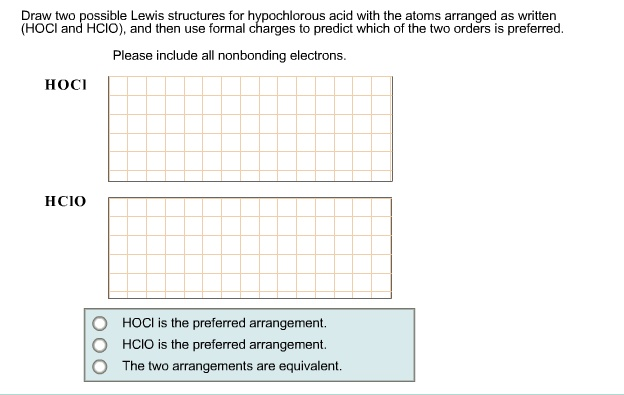Draw two possible Lewis structures for hypochlorous acid with the atoms arranged as written (HOCI and HCIO), and then use formal charges to predict which of the two orders is preferred. Please include all nonbonding electrons. HOCI HCIO HOCI is the preferred arrangement. HCIO is the preferred arrangement. The two arrangements are equivalent.

The Correct Answer and Explanation is:
Here is the step-by-step solution:
1. Calculate the total number of valence electrons:
- Hydrogen (H) is in Group 1 and has 1 valence electron.
- Oxygen (O) is in Group 16 and has 6 valence electrons.
- Chlorine (Cl) is in Group 17 and has 7 valence electrons.
- Total valence electrons = 1 + 6 + 7 = 14 electrons.
2. Draw the Lewis structure for the HOCl arrangement:
- Skeleton: The atoms are connected in the order H-O-Cl.
- Bonds: Draw single bonds between the atoms (H-O-Cl). This uses 4 electrons (2 bonds x 2 electrons/bond).
- Lone Pairs: Distribute the remaining 10 electrons (14 – 4) as lone pairs to satisfy the octet rule for oxygen and chlorine (hydrogen is satisfied with a single bond).
- Place 6 electrons (3 lone pairs) on the terminal chlorine atom.
- Place the remaining 4 electrons (2 lone pairs) on the central oxygen atom.
- Final HOCl Structure:
- H is bonded to O.
- O is bonded to Cl.
- O has 2 lone pairs.
- Cl has 3 lone pairs.
- All atoms have a complete valence shell (H has 2, O has 8, Cl has 8).
3. Draw the Lewis structure for the HClO arrangement:
- Skeleton: The atoms are connected in the order H-Cl-O.
- Bonds: Draw single bonds between the atoms (H-Cl-O). This uses 4 electrons.
- Lone Pairs: Distribute the remaining 10 electrons (14 – 4) as lone pairs.
- Place 6 electrons (3 lone pairs) on the terminal oxygen atom.
- Place the remaining 4 electrons (2 lone pairs) on the central chlorine atom.
- Final HClO Structure:
- H is bonded to Cl.
- Cl is bonded to O.
- Cl has 2 lone pairs.
- O has 3 lone pairs.
- All atoms have a complete valence shell (H has 2, Cl has 8, O has 8).
4. Calculate Formal Charges to determine the preferred structure:
The formula for formal charge is:
Formal Charge = (Valence Electrons) – (Nonbonding Electrons) – ½(Bonding Electrons)
- For the HOCl structure:
- Formal Charge (H) = 1 – 0 – ½(2) = 0
- Formal Charge (O) = 6 – 4 – ½(4) = 0
- Formal Charge (Cl) = 7 – 6 – ½(2) = 0
- For the HClO structure:
- Formal Charge (H) = 1 – 0 – ½(2) = 0
- Formal Charge (Cl) = 7 – 4 – ½(4) = +1
- Formal Charge (O) = 6 – 6 – ½(2) = -1
Conclusion:
The most stable and preferred Lewis structure is the one where the formal charges on the atoms are minimized (closest to zero). The HOCl arrangement results in zero formal charge for all atoms. The HClO arrangement results in a +1 charge on chlorine and a -1 charge on oxygen. Therefore, the HOCl arrangement is the preferred structure for hypochlorous acid.
Completed Image:
Here are the drawn Lewis structures and the final selection.
HOClGenerated code
..
H - O - Cl:
.. ..content_copydownloadUse code with caution.
(This shows H single-bonded to O, which is single-bonded to Cl. O has two lone pairs, and Cl has three lone pairs.)
HClOGenerated code
.. ..
H - Cl - O :
..content_copydownloadUse code with caution.
(This shows H single-bonded to Cl, which is single-bonded to O. Cl has two lone pairs, and O has three lone pairs.)
[Image of the completed problem with the structures drawn and the correct option selected]Generated code
[In the top box for HOCI, the Lewis structure H-O-Cl is drawn with two lone pairs on O and three lone pairs on Cl.]
[In the bottom box for HCIO, the Lewis structure H-Cl-O is drawn with two lone pairs on Cl and three lone pairs on O.]
[The first radio button is selected]
◉ HOCI is the preferred arrangement.
○ HCIO is the preferred arrangement.
○ The two arrangements are equivalent.